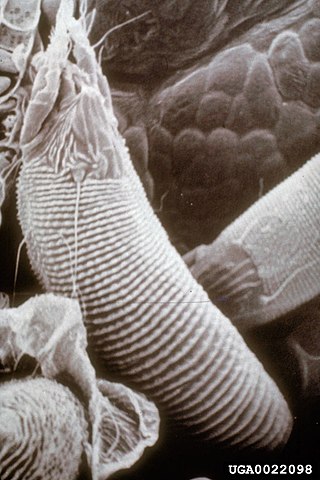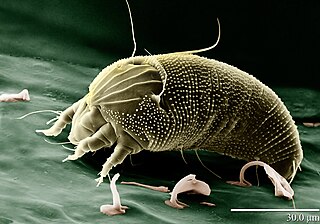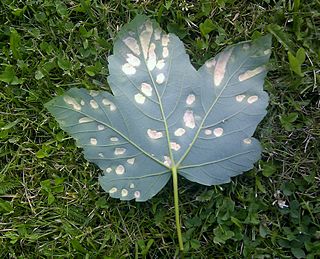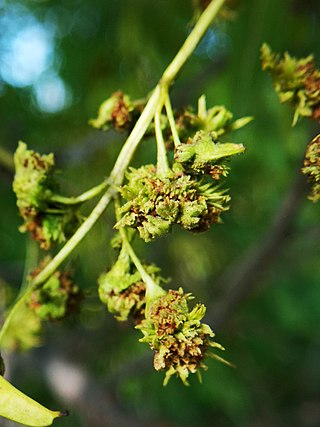
Eriophyidae is a family of more than 200 genera of mites, which live as plant parasites, commonly causing galls or other damage to the plant tissues and hence known as gall mites. About 3,600 species have been described, but this is probably less than 10% of the actual number existing in this poorly researched family. They are microscopic mites and are yellow to pinkish white to purplish in color. The mites are worm like, and have only two pairs of legs. Their primary method of population spread is by wind. They affect a wide range of plants, and several are major pest species causing substantial economic damage to crops. Some species, however, are used as biological agents to control weeds and invasive plant species.

Aceria chondrillae is a gall-forming deuterogynous eriophyid mite. It is often used as a biological control of the noxious weed Chondrilla juncea, a highly competitive herbaceous perennial composite found in Europe, Asia, Australia and North America.

Chondrilla juncea is a species of flowering plant in the family Asteraceae known by a number of common names, including rush skeletonweed, gum succory, devil's grass, and nakedweed. The plant is native to Europe, Asia, and North Africa, but it is known throughout most temperate regions of the world as an introduced species which is usually considered a noxious weed.
Aceria malherbae is a species of gall mite known as the bindweed gall mite. It is used as an agent of biological pest control on invasive species of bindweed, particularly field bindweed.

Salicornia quinqueflora, synonym Sarcocornia quinqueflora, commonly known as beaded samphire, bead weed, beaded glasswort or glasswort, is a species of succulent halophytic coastal shrub. It occurs in wetter coastal areas of Australia and New Zealand.

Aceria is a genus of mites belonging to the family Eriophyidae, the gall mites. These tiny animals are parasites of plants. Several species can cause blistering and galls, including erineum galls. A few are economically significant pests, while others are useful as agents of biological pest control of invasive plants such as rush skeletonweed, creeping thistle, and field bindweed.

Aceria anthocoptes, also known as the russet mite, rust mite, thistle mite or the Canada thistle mite, is a species of mite that belongs to the family Eriophyidae. It was first described by Alfred Nalepa in 1892.

Aceria pseudoplatani causes the sycamore felt gall that is found on the leaves of sycamores or Norway maple, and is caused by an acarine gall-mite.

Aceria fraxinivora, also known as the cauliflower gall mite and the ash key gall, causes the growths, known as galls, found on the hanging seeds or "keys" of the ash (Fraxinus) species.

Aceria erinea is a species of mite which causes galls on the leaves of walnut. It was first described by Alfred Nalepa in 1891.
Eriophyes tulipae, commonly known as the dry bulb mite, is a species of mite in the genus Eriophyes. This mite feeds on members of the lily family, and has damaged garlic crops. At one time, it was also thought to feed on wheat and other grasses, but the wheat curl mite is now regarded as a different species, Aceria tosichella.
Aceria iteina is a species of mite which causes galls on the leaves of sallows and their hybrids. It was first described by Alfred Nalepa in 1925.

Aceria nervisequa is a species of mite that belongs to the family Eriophyidae. It is found in Europe and was first described by Giovanni Canestrini in 1891. The mite causes galls on the leaves of beech,
Acalitus calycophthirus is an eriophyid mite which causes big bud galls on birch twigs. It is found in Europe and was first described by the Austrian zoologist, Alfred Nalepa in 1891.

Aceria elongata, the crimson erineum mite, is a species of eriophyid mite. This microscopic organism induces erineum galls on the upper leaf surfaces of sugar maple, and is known from the east coast of United States and Canada.

Aceria campestricola, is a species of mite in the family Eriophyidae. The mite causes galls on the leaves of elms and was described by Georg Ritter von Frauenfeld in 1865.

Aceria fraxini, the ash bead gall mite, is a species of mites in the family Eriophyidae, the gall mites.

Aceria fraxiniflora, the ash flower gall mite, is a species of gall mite that produces galls on ash trees. The male flowers of ash are greatly distorted by the mites, which results in a highly disfigured and disorganized gall that remains yellow or green, and later dries and turns brown. However, there is little evidence that this injury has a substantial impact on the ash plant's health.

Aceria mackiei, previously Eriophyes mackiei, the live oak erineum mite, is an abundant eriophyoid mite that produces leaf-blister galls on coast live oak, interior live oak, huckleberry oak, and canyon live oak. This mite's ability to induce galls in oaks of both the black oak group and the intermediate oak group is unique. The distribution of this arthropod is western North America.

Aceria baccharices, also known as the mulefat leaf-blister mite and formerly known as Eriophyes baccharices, is a species of arachnid native to North America that induces galls on two California willows, Baccharis salicifolia and Baccharis glutinosa. This mite was first described to science by Hartford H. Keifer in 1945. According to Keifer, "the type host is the long-leaf type Baccharis which is common to dry washes in northern California. The other host is the same sort of thing but confined to the south." These galls, which look like warty protrusions from the surface of the leaf, are nurseries for the next generation of mites. The adults eventually leave the leaf via anterior exit holes that may be visible.















